Cylindrical Three-Dimensional Dust-Ion Acoustic Propagation in Plasmas
S.K.El-Labany,E.K.El-Shewy,H.N.Abd El-Razek,,2and A.A.El-Rahman
1Theoretical Physics Group,Faculty of Science,Domietta University,Domietta,Egypt
2Department of Physics,Taibah University,Al-Madinah Al-Munawarrah,Kingdom of Saudi Arabia
3Theoretical Physics Group,Faculty of Science,Mansoura University,Mansoura,Egypt
4Department of Physics,Faculty of Science,Assiut University,New Valley Branch,New Valley,Egypt
AbstractWave properties of solitons in an unmagnetized four-component dusty plasma system contains isothermal distributed electrons,mobile ions,and negative-positive dusty grains have been examined.To study DIA wave properties,a reductive perturbation(RP)analysis is used.By a reductive perturbation(RP)analysis under convenient coordinate transformation,the three dimension Kadomtsev-Petviashvili equation in cylindrical coordinates is obtained.The effects of dust grain charge on soliton pulse structures are studied.More specifically,solitary pro file depending on the axial,radial,and polar angle coordinates with time is discussed.This investigation may be viable in plasmas of the Earth’s mesosphere.
Key words:dust plasmas,3D-CKP equation,dusty-ion acoustic solitary waves,isothermal electrons
1 Introduction
No doubt,studying of nonlinear waves and their structures in plasmas with charged dust grains is one of important activities during the last few decades for explaining many systems in astrophysics(Earth magnetosphere,cometary tails,nebulas,mesosphere),[1−4]as well as in the laboratory.[5−6]Moreover,it has remarkable applications in fiber optics,plasmas of semiconductor,and dust-crystals.[7−9]The charged grains in plasmas change plasma features,and define new types of wave phenomena.[10−13]Many investigations are made to expound the applications of nonlinear properties in astrophysics and space dust plasmas.[14−16]It has been reported that dusty grains in multicomponent plasmas influenced the collective interactions in plasmas[17]and the variation of dust charge modified shock features.[18−20]Many articles discussed the negative dusty plasma applications in space.[21−22]On the other hand,in other studies,both negative-positive grains are taken into account in space plasma[23−24]and in plasma laboratories.[25]On the other hand,a new dust grain model has been approached for cometary plasmas having opposite charges polarity in the depletion of electrons and ions.[26]Later,plasma containing ions,electrons,grains with positivelynegatively charged was inspected.[27]It was investigated that,new positively grain component caused the existence of twofold solitary potentials. Furthermore,shock behavior in inhomogeneous plasmas with ionizing source is examined.[28]They reported that,charge polarity fluctuation of dusty charge improved the monotonic characteristics of shock waves.However,many of these studies are regarded to the unbounded planar geometry.This is not true for space and laboratory plasma.So we have taken the non-planar form of cylindrical geometry into account.Several theoretical studies in non-planar geometry on the dust plasmas features have been deliberated.[29−32]A multidimensional cylindrical form of Kadomtsev-Petviashvili equation(CKP)in dusty plasmas with two superthermality distributed temperature ions has been introduced.[32]Finally,El-Bedwehy et al.investigated CKP equation in a plasma of two charged dust grains.[33]They examined features of soliton formation that depends on with the polar,radial and axial coordinates.
Our article is to explore the non-planar(cylindrical)three-dimensional DIAWs in four components dust plasma system contains isothermal electrons,mobile ions and negative-positive dust grains.We study the effects of ion to electron number density ratio,negative dust grain to electron density ratio and positive grain with an electron number density ratio on nonlinear wave phase speed as well as on the pulse width and amplitude.In addition,the effect of non-planar geometry on the pulse pro file is studied.The organization of this paper is as follows.In Sec.2,we present model equations.In Sec.3,the derivation of CKP equation is present.Its solution is given in Sec.4.Section 5 is devoted for results and discussion.
2 System of Equations
Consider a three-dimensional,unmagnetized dusty plasma system whose constituents is isothermal dis-tributed electrons,mobile ions,negative and positive dusty grains.The three-dimensional continuity equations for mobile components are given by
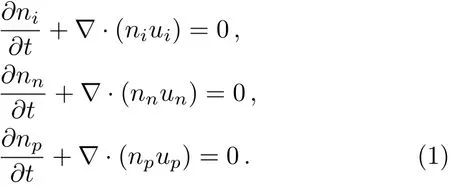
The corresponding momentum equations are,

These equations are supplemented by Poisson’s equation:

In the above equations nj(j=i,n,p,e)are the perturbed number densities and ni0,nn0,np0,and ne0are the related equilibrium values.Also uj(j=i,n,p)are the ion,negative and positive dusty plasma velocities,respectively,normalized by the ion sound velocity(KBTe/mi)1/2,ϕ is the electrostatic potential and normalized by(KBTe/e),time variable t and space coordinate are normalized by inverse of the plasma frequencyand electron Debye length,respectively,µ=Znmi/mn,α=Zpmi/mp,Here,KBand Teare Boltzmann constant and temperature of electron,e the electronic charge,mj(j=i,n,p)denote ion,negative and positive dust masses respectively.
From the charge neutrality condition,we have

with

where Znand Zpare charge numbers of negative and positive grains,respectively.
3 Nonlinear Calculations
To study DIA wave properties,a reductive perturbation(RP)analysis is used.[34]We introduce the new independent variables:[35−36]

where ϵ is a small parameter measures the degree of perturbation and the λ is the wave propagation velocity.The dependent variables in the model are expanded in the powers of ϵ as


where uj,vj,and wjare the ion,negative and positive dust velocities in R,Θ,and Z directions,respectively.Substituting Eqs.(5)and(6)to Eqs.(1)–(3),the firstorder in ϵ for ion are

whereas for negative dust are given by

and for positive dust are given by

Poisson equation leads to the compatibility condition:

At the next order in ε,the evolution equation for the first order perturbed electrostatic potential in the form

The nonlinear and the dispersion coefficients A and B are given by

Equation(11)is a 3D-CKP equation for dust-ion acoustic waves. If we neglect Z and Θ dependence,Eq.(11)is reduced to KdV equation.
4 3D-CKP Solution
In order to solve Eq.(11),the generalized expansion method is used.[37]According to the transformation

the exact solution of Eq.(11)is given by[31−32,37]

where,the amplitude ϕ0and the width ∆ are given by

with

while Lrand Lzare the direction cosines in R and Z axes,with condition=1 and U0is an arbitrary constant.Also note that the product ϕ0∆2=is independent of U0but depends on λ.
5 Results and Discussion
To carry out this study,many conditions are introduced(i)for model components,our assumption is isothermal electrons and cold fluid of ions and dust grains[38](ii)the gravitational effect is neglected for submicron dusty grains[38−39](iii)the plasma is of low coupling parameter(iv)inter-grain distance is very small.By applying reductive perturbation theory,introduced by Taniuti and Wei(1968),[34]this plasma model leads to a 3D-CKP equation(11).Now we discuss effects of system parameters on the feature of dust ion acoustic soliton solution using mesospheric parameters.[40−43]The dependence of solitons features i.e.wave phase velocity λ,soliton amplitude and width ϕ0and ∆ on the various parameters ρ(unperturbed number densities ratio ρ=ni0/ne0),µ(normalized ion to negative dust mass ratioµ=Znmi/mn),α(normalized ion to positive dust mass ratio α =Zpmi/mp),η (normalized charge number of positive dust η =Zpnp0/ne0)and ν (normalized charge number of negative dust ν=Znnn0/ne0)are investigated.Also,the geometric effect on the acoustic waves is considered.Figures 1 and 2 show the variation of the phase velocity λ against ν, η, α and µ.It is clear that λ is elevated with ν,α and µ but is reduced with η.
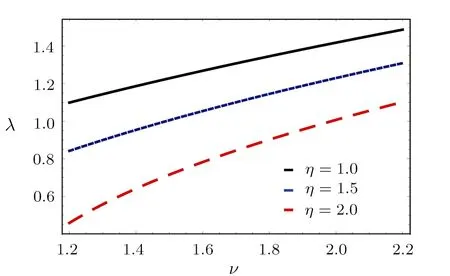
Fig.1 The change of λ against ν for various values of η and for α =0.002,and µ =0.005.
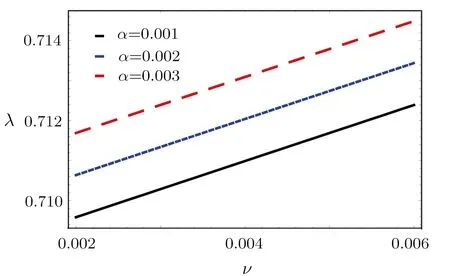
Fig.2 The change of λ against µ for various values of α and for ν =1 and η =1.5.

Fig.3 Variation of the amplitude ϕ0against Lrand η for α =0.002, µ =0.005,and ν =1.5.

Fig.4 Change of amplitude ϕ0against Lrand η for α=0.002,µ =0.005,and ν =1.1.

Fig.5 Change of amplitude ϕ0against Lrand η for α=0.002,µ=0.005,ν=1.1,and(a)U0=0.95;(b)U0=0.4.
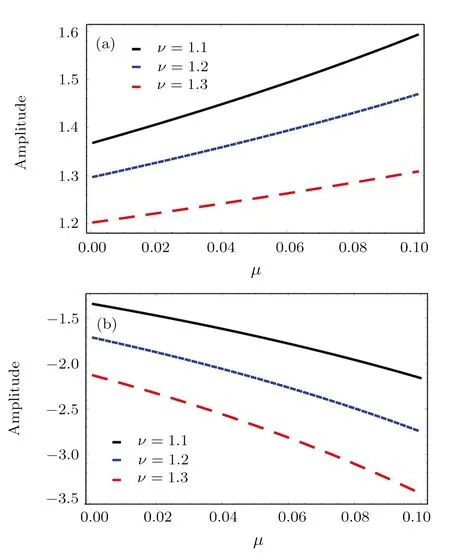
Fig.6 Change of the amplitude ϕ0against µ for different values of ν and for α =0.002,Lr=0.5,η =1.3,and(a)U0=0.95;(b)U0=0.4.
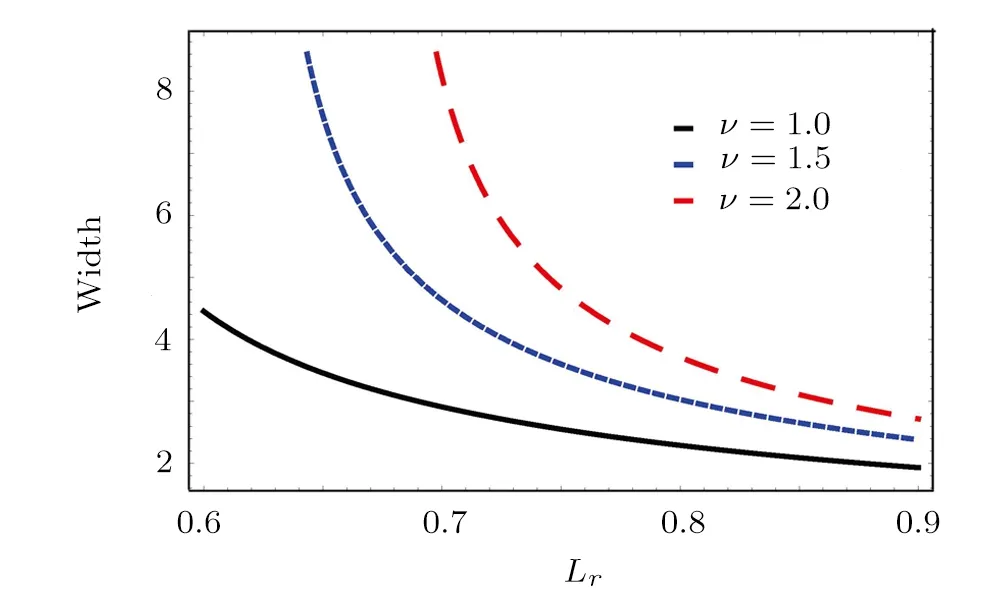
Fig.7 Change of width ∆ against Lrand ν for α =0.002,µ=0.005,η=1.5,and U0=0.5.
Figure 3 exhibits the variation of soliton amplitude ϕ0with Lrand η.Clearly,this model supports both rarefactive and compressive solitons,depending on sign of nonlinear coefficient A,compressive type exists if A>0 while rarefactive for A<0.More specifically,plots of soliton amplitude ϕ0and ∆ (width)against η,U0,Lr,and ν are depicted in Figs.4–8.The soliton amplitude ϕ0of both compressive and rarefactive wave increases with Lrand η,as shown in Fig.4.Accordingly,Lrand η lead to reduce the pulse amplitude ϕ0.Also,the soliton amplitude ϕ0of compressive soliton decreases with ν but increases with Lr, µ,and η up to a certain value(Lr=0.55),then ϕ0begins to decrease with η.While the soliton amplitude ϕ0of rarefactive soliton decreases with ν and µ and increases with Lrand η as depicted in Figs.5 and 6.
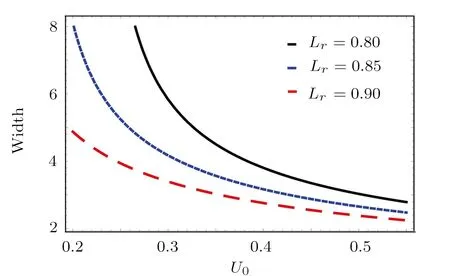
Fig.8 The change of the width∆against U0for different values of Lrand for α =0.002,µ =0.005,ν =1.5,and η=1.5.

Fig.9 Three-dimensional solitary wave pro file ϕ(14)against R and Θ at T=0.5 and Z=0.5 and for Lr=0.9,α=0.002,µ=0.005,ν=1.5,η=1.5,and(a)U0=0.3;(b)U0=0.6.

Fig.10 Three-dimensional solitary wave pro file ϕ(14)against R and Θ at T=0.5 and Z=0.5 and for Lr=0.9,α =0.002,U0=0.5,µ =0.005,ν =1.5,and η =1.5.

Fig.11 Three-dimensional solitary wave pro file ϕ(14)against R and Z at T=0.5 and Θ=0.2 and for Lr=0.9,U0=0.2,α =0.002,µ =0.005,ν =1.5,and η =1.5.
On the other hand,Figs.7 and 8 show the soliton width ∆dependence on ν,Lrand U0.It is seen that ∆increases with ν whereas it decreases with both Lrand U0.It is shown that ν makes the solitary pro file much wider.According to soliton picture.[44−45]Figures 9–11 display ϕ in Eq.(14)with Θ,R and Z,and T.It is noted that,soliton deviates towards the positively radial axis with increasing time and this cannot occur on neglecting Z and Θ coordinates.The DIA soliton is shown in Fig.9 with R and Θ for two values of U0=0.3 and=0.6.It is seen that how DIA amplitude varies with U0.The one dimensional model cannot explain such behavior.
Summing up,we have studied DIASWs propagation in plasma with isothermal electrons,mobile cold ions,positive and negative dust grains considered cylindrical geometry.The angular and radial dependence have been considered.Employing the(RP)technique,a 3D-CKP equation which describes the evolution of DIASWs has been derived and its localized solution has been obtained by reducing the 3D-CKP to the Korteweg-de Vries equation on employing a simple transformation of the coordinates. The effects of system parameters(ν,η,µ,Lrand U0)on phase velocity λ,soliton amplitude ϕ0,and width∆have been examined numerically.We have shown graphically that these parameters play a vital role in the formation and the features of the DIA mesospheric solitary waves.[38,46−47]These results agree with the mesospheric plasma information,see Refs.[46–47].Finally,our investigation of the solitary wave properties could be important in understanding nonlinearity features in space,as well as in laboratory and astrophysical environments in mesospheric plasma.
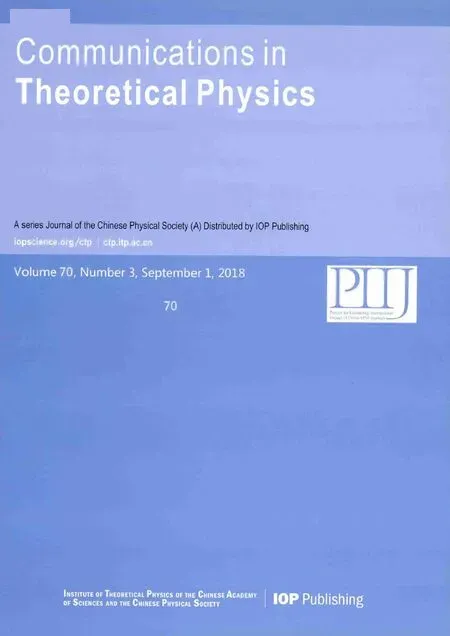 Communications in Theoretical Physics2018年9期
Communications in Theoretical Physics2018年9期
- Communications in Theoretical Physics的其它文章
- Vertical Sediment Concentration Distribution in High-Concentrated Flows:An Analytical Solution Using Homotopy Analysis Method
- Significance of Darcy-Forchheimer Porous Medium in Nano fluid Through Carbon Nanotubes
- Third-Order Optical Nonlinearity in Two-Dimensional Transition Metal Dichalcogenides∗
- Nano Fluid Flow Analysis in the Presence of Slip Effects and Wall Properties by Means of Contraction and Expansion∗
- Improving the Performance of Practical Decoy-State Measurement-Device-Independent Quantum Key Distribution with Biased Basis Choice∗
- Quadruple Gaussian Laser Beam Pro file Dynamics in Collisionless Magnetized Plasma
